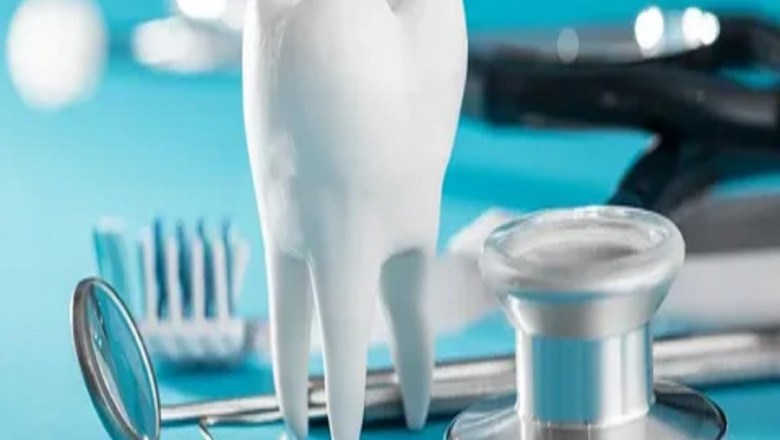views
Tooth Extractions
One of the most common Dental procedures is a tooth extraction. This involves surgically removing one or more teeth from the mouth. There are a few reasons a dentist may recommend an extraction:
- Severe tooth decay: If a large portion of a tooth is decayed and can't be restored with a filling, crown, or root canal, extraction may be needed. Extensive decay weakens the tooth structure making it prone to additional problems.
- Periodontal (gum) disease: Advanced gum disease that has destroyed the bone supporting a tooth requires extraction to prevent further deterioration. Gum disease can lead to tooth loss over time if not treated.
- Dental fractures: A tooth that has cracked or broken below the gumline due to injury usually needs extracting. Large fillings or cracks also weaken teeth, risking additional fractures.
- Orthodontic treatment: Removing extra baby teeth that fail to fall out naturally or premolars to make space for crowded teeth moving during braces.
- Impacted wisdom teeth: Vertical or skewed positioning makes third molars difficult to clean, increasing the risk of decay and complications like infection. Preventive removal is often advised.
Extractions are performed locally with numbing medicine injected near the tooth. Forceps, elevators, or occasionally surgery are used to carefully lift and twist out the tooth. Medications may be prescribed to manage any minor pain or swelling afterward. The extraction site then heals on its own.
Fillings
Another fundamental dental procedure is placing a filling. When a tooth develops a small cavity, the dentist cleans out any decayed material with a drill or laser. They then tightly pack the remaining hole with a filling material like silver amalgam or tooth-colored composite resin.
Amalgam fillings contain liquid mercury and powdered silver, tin, and copper. They are very durable and long-lasting but not aesthetically pleasing. Composite fillings mimic the natural appearance and function of enamel. They are more commonly used today, especially in front teeth.
The dentist sculpts and hardens the filling to precisely match the surrounding tooth structure. Fillings help restore teeth to their normal contour and function while preventing further decay underneath durable restorative material. Regular checkups allow early detection and treatment of small cavities before they grow into larger problems.
Root Canals
When deep decay reaches the soft inner layers of a tooth called the pulp, a root canal may be needed. Infection or death of this pulp tissue causes severe tooth pain and makes the tooth non-restorable via a filling. The primary goals of a root canal are to disinfect and seal the inside of the tooth.
The root canal procedure involves carefully cleaning, shaping, and disinfecting the intricate root canals with tiny endodontic files and irrigation solutions. Calcium hydroxide medicaments may be temporarily placed to eliminate any lingering infection. At subsequent appointments, the canals are filled with gutta-percha (a rubber-like material) then sealed at the crown with a permanent filling or crown.
A successful root canal preserves the natural tooth structure rather than requiring extraction. Teeth that receive root canals and protective crowns can last a lifetime. With proper routine follow-up care from a dentist, they function just as well as natural teeth.
Crowns
Crowns, also called dental caps, are restorations placed over damaged or cracked teeth. Several factors influence the need for a crown like a large pre-existing filling, fracture, or root canal treatment weakening a tooth’s structure. Crowns strengthen teeth, restoring their shape, size, and alignment. Different crown materials include:
- Porcelain fused to metal: Strongest type made from porcelain bonded to a metal inner surface. Looks very natural.
- All-porcelain or ceramic crowns: More translucent material mimicking the appearance of natural enamel. More brittle than porcelain fused to metal.
- Temporary crowns: Soft, plastic material like acrylic used for a short time immediately after shaping and preparing a tooth until its permanent crown is fabricated. Protects the exposed inner structures.
The dentist first shaves down and shapes the natural tooth to receive the crown restoration. An impression captures its exact size and position. Within 1-2 weeks, the permanent crown is cemented securely into place with dental cement or adhesive resin. From then on, the crown protects fragile tooth structure from fracturing while biting or grinding.
This some typical dental procedures to maintain oral health and restore damaged teeth back to proper form and function. With regular checkups and cleanings, the dentist can identify issues early to surgically treat with minimally invasive procedures before more complex work becomes necessary.
For Deeper Insights, Find the Report in the Language that You want.
About Author:
Priya Pandey is a dynamic and passionate editor with over three years of expertise in content editing and proofreading. Holding a bachelor's degree in biotechnology, Priya has a knack for making the content engaging. Her diverse portfolio includes editing documents across different industries, including food and beverages, information and technology, healthcare, chemical and materials, etc. Priya's meticulous attention to detail and commitment to excellence make her an invaluable asset in the world of content creation and refinement. (LinkedIn- https://www.linkedin.com/in/priya-pandey-8417a8173/)






















Comments
0 comment